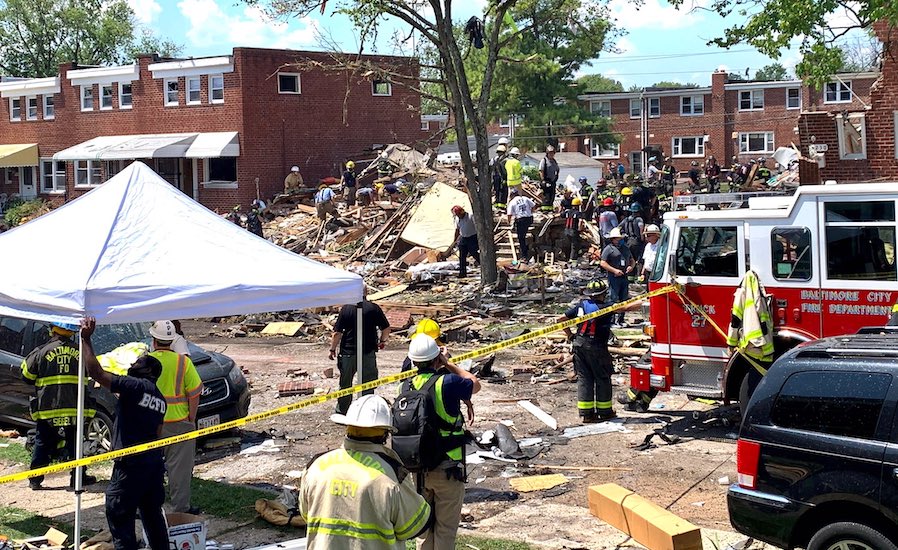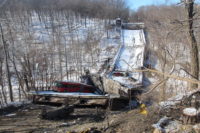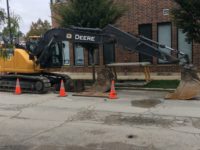Three days after a natural gas explosion in Baltimore killed at least two persons and injured seven, investigations to find the cause continued.
Initially, a natural gas leak had been the suspected source of the Aug. 10 explosion in a northwest Baltimore residential neighborhood. But Baltimore Gas & Electric, the city's main gas utility, said in an Aug. 13 update that its inspections determined none of its equipment, including gas mains, service pipes, meters and electric equipment, caused the explosion.
The company added that all of its equipment "has been operating safely."
BGE also said that investigators were "examining customer-owned gas piping and appliances at the scene."
It said multiple agencies are involved in the investigation, including the Baltimore City Fire Dept. and other local, state and federal agencies.
The company reiterated earlier statements that surveys on Aug. 10 and 11 found no leaks in its gas mains and gas service pipes and found no gas readings in any of the buildings on the scene.
As it had stated earlier, BGE said no leaks were reported to the company about the affected properties within the past five years and "routine inspections in June and July 2019 found no leaks."
The explosion, which occurred just before 10 a.m., leveled three 1960s-era row houses, and severely damaged a fourth. Neighbors joined firefighters in combing the wreckage by hand in search of survivors, several of whom were believed to be children. Rescuers eventually freed two people, who were evacuated to a nearby hospital.
The federal Pipeline and Hazardous Materials Safety Administration (PHMSA) has an investigator at the scene "to provide technical assistance to state and local investigations," a spokesman told ENR via email on Aug. 11.
The National Transportation Safety Board investigates some pipeline accidents. But Christopher O'Neil, an NTSB spokesman, told ENR via email late on Aug. 10, "While initial information is still being gathered, initial indications are that the NTSB would not have jurisdiction for this accident. O'Neil added, "Should that change, we will announce accordingly."
Concerns about the age and safety of the thousands of miles of pipes that make up BGE’s underground infrastructure have grown in step with a rise in leaks reported to federal regulators. A 2019 Baltimore Sun newspaper story reported that during the previous year, the utility logged approximately 3,600 leaks classified as hazardous, and reported a sharp rise in the number of pipe joint failures. The newspaper report came a month after a BGE gas leak caused an explosion that severely damaged a suburban Baltimore office building.
In testimony earlier this year before the Maryland Public Service Commission, a BGE executive estimated that one-third of the utility’s gas distribution mains, one-quarter of its gas services and half of its transmission mains are more than 50 years old, with 15% of its gas distribution system made of “outmoded” materials. A 20-year pipeline improvement program has been underway since 2013.
BGE said in its Aug.13 statement the medium-pressure gas mains and service pipes in the neighborhood where the explosion occurred are "very safe and highly reliable with low leak rates." It noted that the mains and pipes were installed in the 1960s and include "protected steel materials."
The company added that its current modernization program, which has cost more then $560 million since 2014, focuses mainly on removing "low-pressure cast iron, unprotected steel and copper pipes," which constitute less than 20% of its gas system but account for 70% of its leaks.
Those materials aren't used in the neighborhood where the explosion occurred, BGE said.
Federal data on gas pipeline incidents
According to PHMSA data, from 2000 through 2019 there were 594 serious incidents involving gas distribution lines, from 2000 through 2019, resulting in 202 fatalities and 918 injuries.
The agency, part of the U.S. Dept. of Transportation, classifies serious incidents as those involving a fatality or an injury requiring in-patient hospitalization.
In 2019, there were 23 serious gas distribution incidents, 11 fatalities and 26 injuries.
For 2020, through Aug. 9, there have been 10 serious incidents in gas distribution lines, with 1 fatality and 11 injuries.
Story updated on 8/11/20 with new fatality total, new Baltimore Gas and Electric company statement and federal data on gas pipeline incidents, fatalities and injuries.







Post a comment to this article
Report Abusive Comment